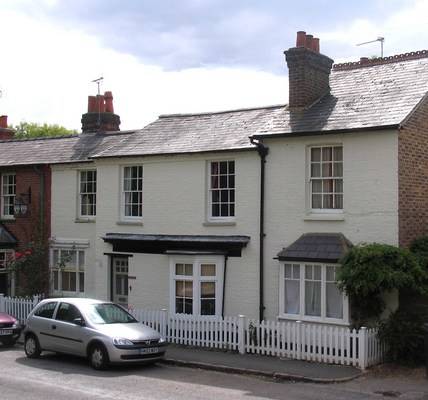Archived Page
This page is no longer maintained.
For up-to-date information please see the
new website
Old Manor House, Rectory Road, Taplow
Whatís in a name? "Old" is a word rightly associated with many named properties in Taplow (Old Cottage, Old Malt House, Old Rectory, etc.) but Old Manor House seems a bit strong for a couple of farm cottages, joined together and extended over many years. We donít believe our house was ever a manor house but it is old and has quite an interesting history. However, if I was trying to make a case for our property once being the Manor House, I could mention a number of possible qualifications. The records we have only go back to 1886 when the property (known then as the Old Manor House) was occupied by a certain Baron Rozenkrantz. However, we believe parts of the house to be at least 200 years older. From the deeds it is clear that the property included a house, a bakehouse and a shop, and extended over a lot of land once upon a time, including the area now covered by Elm View Cottages, "to a total of thirty-six perches". There were several outbuildings, including a stable yard, but of these only the foundations now remain. We have ghosts. There is a small room in the middle of the house that has no exterior windows. Many years ago I used it as an office and I frequently saw an elderly lady walking past an internal window. I subsequently discovered that such a lady had lived and died in this very room about 60 years earlier. There is another unconfirmed story about a man who fled up the chimney at the Old Manor House to escape a pack of wild dogs and never came down again. We have not seen him, but I sometimes wonder if the howl we hear from the chimney when I light the fire really is caused by the wind.
We have a wine cellar. When we bought the house in 1984, the only access to the cellar was down a flour chute (for the bakehouse) in the conservatory. The floor was covered in earth and you could barely stand upright even if you were of only average height. My son, Richard, discovered the staircase but it was broken down and went nowhere, so for several years the cellar was difficult to access. But, with my love of collecting fine wine, it was only a matter of time before I would attempt to restore it. And so it was that last year we employed a small company, which specialises in old properties, to give it a go. First of all they had to remove 20 tons of earth, which we believe were the footings from the later construction of the small cottage "Mysteria" next door. To the amazement of all, they found a magnificent brick floor under two feet of earth and it was in very good condition. They also found several interesting mementoes from the past, including graffiti dated 1812 and a beer bottle embossed "Langdons, Maidenhead". Furthermore, they found a fireplace and a window frame, indicating that the cellar was once above ground. When I look around my restored wine cellar, it amuses me to think that my oldest bottle of port, which is dated 1900, would presumably have been considered far too young to drink by Baron Rozenkrantz.
We have a very old barn, which is our kitchen and has recently been restored. The exposed oak beams have been identified by a naval historian as particular sections of old naval ships. To think that they might have seen action at Trafalgar...!
Our garden is on two levels, due perhaps to a large deposit of soil from the Elm View footings to raise the upper level. We frequently discover interesting bits of pottery and flintstone in the garden but our greatest discovery was made by accident. My wife, Liz, was collecting material from the compost heap when the ground way gave way and her leg disappeared down a hole right up to her hip. The hole was the opening to an impressive Victorian brick cesspit, as confirmed later by the local Archaeological Society.
Looking at our house from the Village Green, it is clear from the design of the windows and the roofline that the half attached to the pub was once part of a block of four terraced cottages. The other half, however, is of a quite different design and was once a shop, as a photograph of the front of our house dated 1880 clearly shows.
So, if German barons, stable yards, ghosts, barns and old oak beams, cellars and cesspits constitute claims for the existence of a Manor House, we have the genuine article. On the other hand, I canít help feeling that Taplow Court, Cliveden and Dorney Court have greater claims and I personally favour Taplow Court because of its history and its physical position in the village.
Alistair Forsyth
We have ghosts. There is a small room in the middle of the house that has no exterior windows. Many years ago I used it as an office and I frequently saw an elderly lady walking past an internal window. I subsequently discovered that such a lady had lived and died in this very room about 60 years earlier. There is another unconfirmed story about a man who fled up the chimney at the Old Manor House to escape a pack of wild dogs and never came down again. We have not seen him, but I sometimes wonder if the howl we hear from the chimney when I light the fire really is caused by the wind.
We have a wine cellar. When we bought the house in 1984, the only access to the cellar was down a flour chute (for the bakehouse) in the conservatory. The floor was covered in earth and you could barely stand upright even if you were of only average height. My son, Richard, discovered the staircase but it was broken down and went nowhere, so for several years the cellar was difficult to access. But, with my love of collecting fine wine, it was only a matter of time before I would attempt to restore it. And so it was that last year we employed a small company, which specialises in old properties, to give it a go. First of all they had to remove 20 tons of earth, which we believe were the footings from the later construction of the small cottage "Mysteria" next door. To the amazement of all, they found a magnificent brick floor under two feet of earth and it was in very good condition. They also found several interesting mementoes from the past, including graffiti dated 1812 and a beer bottle embossed "Langdons, Maidenhead". Furthermore, they found a fireplace and a window frame, indicating that the cellar was once above ground. When I look around my restored wine cellar, it amuses me to think that my oldest bottle of port, which is dated 1900, would presumably have been considered far too young to drink by Baron Rozenkrantz.
We have a very old barn, which is our kitchen and has recently been restored. The exposed oak beams have been identified by a naval historian as particular sections of old naval ships. To think that they might have seen action at Trafalgar...!
Our garden is on two levels, due perhaps to a large deposit of soil from the Elm View footings to raise the upper level. We frequently discover interesting bits of pottery and flintstone in the garden but our greatest discovery was made by accident. My wife, Liz, was collecting material from the compost heap when the ground way gave way and her leg disappeared down a hole right up to her hip. The hole was the opening to an impressive Victorian brick cesspit, as confirmed later by the local Archaeological Society.
Looking at our house from the Village Green, it is clear from the design of the windows and the roofline that the half attached to the pub was once part of a block of four terraced cottages. The other half, however, is of a quite different design and was once a shop, as a photograph of the front of our house dated 1880 clearly shows.
So, if German barons, stable yards, ghosts, barns and old oak beams, cellars and cesspits constitute claims for the existence of a Manor House, we have the genuine article. On the other hand, I canít help feeling that Taplow Court, Cliveden and Dorney Court have greater claims and I personally favour Taplow Court because of its history and its physical position in the village.
Alistair Forsyth
